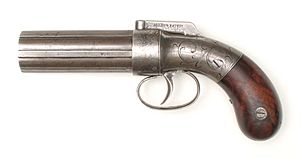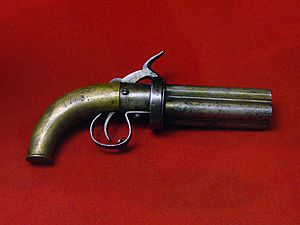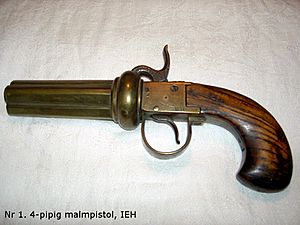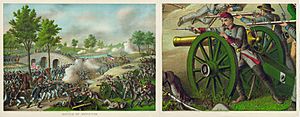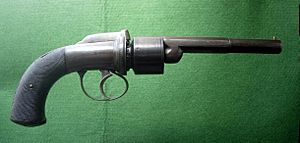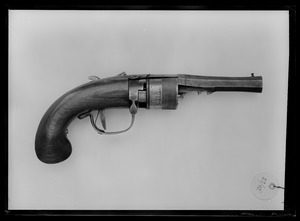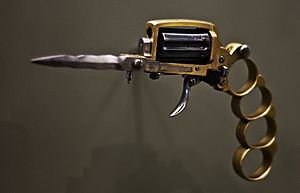Pepper-box facts for kids
The pepperbox revolver is a special type of handgun. It has three or more gun barrels that spin around a central point, a bit like a pepper shaker! Each barrel holds one bullet. When you want to fire, you turn the barrels so the next one lines up with the hammer. This is similar to how a modern revolver's cylinder spins.
Pepperbox guns were made for many different types of firearms, from very old ones like matchlocks to newer ones using metal cartridges. Most pepperboxes were small handguns, but a few larger ones, like muskets or shotguns, were also made. For example, Samuel Colt once owned a three-barrel pepperbox musket from India.
Contents
How Pepperboxes Started
This type of gun became very popular in North America from the 1830s until the American Civil War. But the basic idea is much older! In the 1400s, there was a weapon called a Ribauldequin. It was a type of "volley gun" with many barrels attached to a wooden stock. Each barrel was fired one by one using a match.
Around 1790, pepperboxes were made using a system called "flintlock." Famous gunmakers like Nock in England and "Segallas" in Belgium made them. These early pepperboxes had three, four, or even seven barrels. You had to turn the barrels by hand to get ready for the next shot.
A big change happened with the invention of the percussion cap. This small cap made guns much easier to fire. Along with the Industrial Revolution, it meant pepperbox revolvers could be made in large numbers. This made them much cheaper than the old handmade guns, so more people could afford them.
Early examples include the American three-barrel Manhattan pistol and the English Budding. Most percussion pepperboxes had a round edge at the back of the barrels. This helped stop the caps from accidentally firing if the gun was bumped or dropped. It also protected people's eyes from tiny pieces of the cap when the gun fired.
Why Pepperboxes Were Popular
The pepperbox, as we mostly know it, was invented in the 1830s. It was designed for everyday people to use, often for self-defense. However, military officers sometimes bought them for their own use too. This design quickly spread across the United States, the United Kingdom, and parts of Europe.
Pepperboxes were similar to later revolvers because they held bullets in separate parts that spun. But unlike revolvers, each part had its own barrel. This made the gun simpler because it didn't need a complex system to line up the barrel and bullet.
At first, these pistols were "muzzle loaders." This means you had to load the bullets from the front of the barrels. But in 1837, a Belgian gunmaker named Mariette invented a pepperbox that loaded from the back. It also had a special ring trigger and barrels that could be unscrewed.
Some early pepperboxes still needed you to turn the barrels by hand. But most had a system that spun the barrels automatically when you pulled back the hammer. Many pepperboxes used a "self-cocking" system. This meant pulling the trigger would spin the barrels, pull back the hammer, and then fire the gun, all in one smooth action. A major maker of these guns in the U.S. was Ethan Allen.
Some pepperboxes fired the bottom barrel instead of the top. Examples include the American Blunt & Syms and the Belgian Mariette, which could have anywhere from three to twenty-four barrels!
One problem with the pepperbox design was that it became very heavy at the front if it had many long barrels. This made it hard to aim accurately. Also, the hammer was often in the way of your sight. Most pepperboxes were used for self-defense at very close range. People often didn't aim carefully but just pointed the gun from their hip. Gunfights usually happened very close up. Because of this, many pepperboxes had "smooth-bored" barrels, meaning they didn't have grooves inside to help the bullet spin and fly straight.
Older multi-shot guns could be dangerous. Sometimes, firing one bullet could accidentally set off the others at the same time! This was called a "chainfire." Later revolvers added special dividers to stop this. Pepperboxes rarely had these dividers, but a chainfire was less dangerous in a pepperbox. This is because each bullet had its own barrel to exit from. This made pepperboxes simpler and safer in some ways, and also cheaper to make than the more complex revolvers that came later.
Transitional Revolvers
A step between the pepperbox and modern revolvers was the "transitional revolver." These guns had a single barrel, but they still used a spinning cylinder, much like a pepperbox. An early example was a revolver from 1739 by Jaumandreu.
These guns kept the pepperbox's percussion cap system but still had problems. They often didn't have a good "cylinder stop." This meant the cylinder might not be perfectly lined up with the barrel when fired. This could damage the gun or even hurt the shooter. Also, the barrel was attached in a way that could weaken the gun over time, making it less accurate.
Like pepperboxes, they often lacked dividers between the caps, increasing the risk of a chainfire. The hammers on these guns often hit weakly, so they needed very sensitive caps, which also increased the chainfire risk. Even with shields to protect the user from cap pieces, there was still a danger of the gun exploding if multiple shots went off at once.
However, a good thing about transitional revolvers was that they could use "rifled barrels." This meant the inside of the barrel had grooves that made the bullet spin, helping it fly straighter and more accurately. Most pepperboxes had smooth barrels, but most transitional revolvers had rifled ones.
Transitional revolvers and pepperboxes slowly started to disappear in the 1850s. This was when true revolvers from famous makers like Colt, Smith & Wesson, and Webley became widely available.
Pepperbox Comeback
The pepperbox had a small "comeback" in the late 1800s. These newer versions were short, easy-to-hide "pocket pistols" that used a different type of bullet called a "pinfire" cartridge. The five-barrel Feilitzenre pistol was almost chosen as the standard sidearm for the Swedish Army officers.
A very unique pepperbox from this time was the Belgian Dolne M1869 Apache revolver. This weapon was supposedly popular with street gangs in Paris. It had a folding knife blade and a "knuckle-duster" handle, making it a multi-tool weapon! These later pepperboxes faded away as pinfire cartridges became less common.
Another interesting pepperbox was the six-barrel Remington Zig-Zag Derringer. Unlike older designs, it had a "double action" ring trigger. This meant you could fire six shots as fast as you could pull the trigger. Gamblers and others who needed a hidden self-defense gun liked these. They could easily hide them in a vest pocket.
Modern Uses
The pepperbox design has been used for a few special weapons in more recent times. For example, in the 1960s, an eight-barrel pepperbox shotgun was designed by Robert Hillberg, but it was never actually produced.
In the 1970s, a company called Heckler & Koch made the five-barrel P11 pistol. This gun was designed as a secret underwater firearm that fired darts using electricity.
The Osa is a Russian four-barrel pistol that fires non-lethal (not deadly) rounds or flare rounds. These also use an electric firing system.
There's even a design for a five-barrel 3D-printed pepperbox handgun called the Reprringer. It gained a lot of attention in the news. People have even been caught making 3D-printed pistols that look like pepperboxes in the UK.
In Popular Culture
In the first season of the show Critical Role, and its cartoon version The Legend of Vox Machina, a character named Percival de Rolo III invents and uses a pepperbox revolver.
See also
- Gatling machine gun
- Ripley machine gun
- Derringer
- Lancaster pistol


